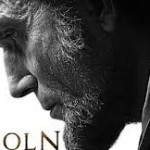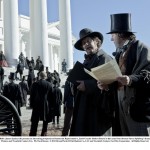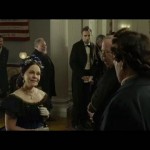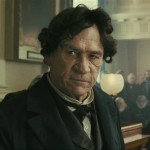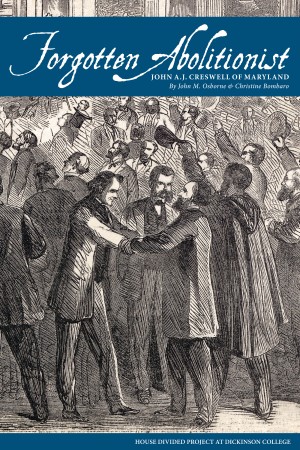GO TO “LINCOLN” MOVIE TEACHER’S GUIDE
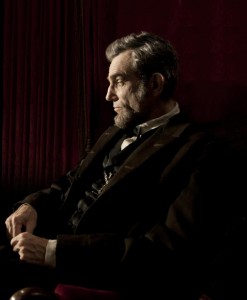 Steven Spielberg’s “Lincoln” (2012) is a two-and-a-half hour film that zeroes in on a defining moment from near the end of the Civil War –January 1865 and the debate over the proposed amendment to the Constitution abolishing slavery. The film claims that it was “Based in Part on Team of Rivals: The Political Genius of Abraham Lincoln by Doris Kearns Goodwin.” However, the script written by playwright Tony Kushner appears much different in focus and style than the popular 2005 joint biography of Lincoln and his selected cabinet rivals. The Goodwin book is searchable through Google here. The time period covered by the film occupies only about ten pages of the book (pp. 685-95). The final script from Kushner is available in full text from Dreamworks here. And below you will find a scene-by-scene summary of the script prepared by House Divided Project Director Matthew Pinsker. The part numbers (50 total) have been assigned by House Divided, but they are grouped by the 20 DVD scene titles (with exact start time locations) provided in the “Scene Selection” menu of the “Lincoln” movie Blu-ray / DVD. You can also download a printable version of this summary here.
Steven Spielberg’s “Lincoln” (2012) is a two-and-a-half hour film that zeroes in on a defining moment from near the end of the Civil War –January 1865 and the debate over the proposed amendment to the Constitution abolishing slavery. The film claims that it was “Based in Part on Team of Rivals: The Political Genius of Abraham Lincoln by Doris Kearns Goodwin.” However, the script written by playwright Tony Kushner appears much different in focus and style than the popular 2005 joint biography of Lincoln and his selected cabinet rivals. The Goodwin book is searchable through Google here. The time period covered by the film occupies only about ten pages of the book (pp. 685-95). The final script from Kushner is available in full text from Dreamworks here. And below you will find a scene-by-scene summary of the script prepared by House Divided Project Director Matthew Pinsker. The part numbers (50 total) have been assigned by House Divided, but they are grouped by the 20 DVD scene titles (with exact start time locations) provided in the “Scene Selection” menu of the “Lincoln” movie Blu-ray / DVD. You can also download a printable version of this summary here.
SCENE 1: OPENING TITLES (00:00)
[EARLY JANUARY 1865]
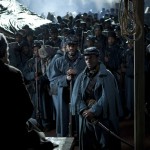 Part 1: (Washington Navy Yard, nighttime) The film opens with a brief flashback to the Battle of Jenkins Ferry (April 30, 1864). Then it shows two free black soldiers conversing with a seated President Lincoln during a cold, wet evening. They are joined by two nervous, young, white soldiers, who soon begin a revealing discussion about the Gettysburg Address.
Part 1: (Washington Navy Yard, nighttime) The film opens with a brief flashback to the Battle of Jenkins Ferry (April 30, 1864). Then it shows two free black soldiers conversing with a seated President Lincoln during a cold, wet evening. They are joined by two nervous, young, white soldiers, who soon begin a revealing discussion about the Gettysburg Address.
SCENE 2: LINCOLN’S DREAM (6:11)
Part 2: (White House interior, nighttime) The second scene opens with a visualization of one of Lincoln’s recent dreams. Abraham & Mary Lincoln are then seen inside Mrs. Lincoln’s White House boudoir, discussing the dream and other subjects, including the possibility of a new push for the proposed Thirteenth Amendment, abolishing slavery.
 Part 3: (White House, 2d floor, nighttime) President Lincoln leaves Mrs. Lincoln, walks down the second floor hallway and lays down with sleeping Tad in his White House office before carrying his youngest son off to bed.
Part 3: (White House, 2d floor, nighttime) President Lincoln leaves Mrs. Lincoln, walks down the second floor hallway and lays down with sleeping Tad in his White House office before carrying his youngest son off to bed.
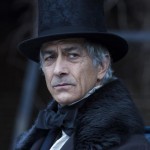 Part 4: (Treasury Department, exterior, morning) There is a brief flagpole dedication, with a very short Lincoln speech and then a carriage ride discussion with Secretary of State Seward and President Lincoln regarding prospects for passage of Thirteenth Amendment; aide John Hay present, shuffling papers.
Part 4: (Treasury Department, exterior, morning) There is a brief flagpole dedication, with a very short Lincoln speech and then a carriage ride discussion with Secretary of State Seward and President Lincoln regarding prospects for passage of Thirteenth Amendment; aide John Hay present, shuffling papers.
SCENE 3: A NEW AMENDMENT (13:57)
Part 5: (White House, 2d floor office, daytime) Lincoln & Seward continue their discussion. Mr. and Mrs. Jolly from Jefferson City, Missouri enter the office and Seward uses the couple to illustrate a point about the Thirteenth Amendment.
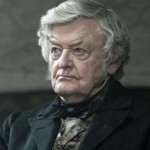 Part 6: (Blair House, evening) Lincoln and Preston Blair discuss the Thirteenth Amendment and also the possibility of opening peace negotiations with Richmond; also participating are two of Blair’s children, Montgomery Blair (former postmaster general) and Elizabeth Blair Lee. Tad Lincoln is present. Afterwards, Preston Blair leaves for Richmond.
Part 6: (Blair House, evening) Lincoln and Preston Blair discuss the Thirteenth Amendment and also the possibility of opening peace negotiations with Richmond; also participating are two of Blair’s children, Montgomery Blair (former postmaster general) and Elizabeth Blair Lee. Tad Lincoln is present. Afterwards, Preston Blair leaves for Richmond.
SCENE 4: WAR POWERS (23:15)
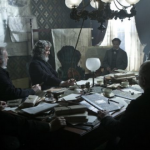 Part 7: (White House, morning) The cabinet meeting includes a discussion of the attack on Fort Fisher / Wilmington, NC and then turns to a discussion of the proposed Thirteenth Amendment that includes vigorous objections from Secretary of Interior John Usher and a lengthy defense of the abolition amendment and his wartime emancipation policies by President Lincoln.
Part 7: (White House, morning) The cabinet meeting includes a discussion of the attack on Fort Fisher / Wilmington, NC and then turns to a discussion of the proposed Thirteenth Amendment that includes vigorous objections from Secretary of Interior John Usher and a lengthy defense of the abolition amendment and his wartime emancipation policies by President Lincoln.
 Part 8: (White House office, afternoon) Lincoln, Seward and Congressman James Ashley discuss plans to bring the Thirteenth Amendment up for a new vote. Ashley objects to the plan, which seems to surprise him, and fears defeat. Lincoln and Seward press hard.
Part 8: (White House office, afternoon) Lincoln, Seward and Congressman James Ashley discuss plans to bring the Thirteenth Amendment up for a new vote. Ashley objects to the plan, which seems to surprise him, and fears defeat. Lincoln and Seward press hard.
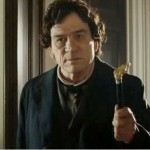 Part 9: (Capitol Hill, office of Rep. Thaddeus Stevens, evening) Chairman of the Ways & Means Committee, Stevens, hosts a meeting of Radical Republicans to discuss their position on whether or not to hold a new vote for the proposed Thirteenth Amendment. There is vigorous debate, especially about Lincoln’s intentions. The group includes Speaker Schuyler Colfax, Senator Benjamin “Bluff” Wade, and Congressman Ashley (sponsor of the Thirteenth Amendment). Also present is a fictional congressman, Asa Vintner Litton, who appears to be a figure somewhat based upon Congressman Henry Winter Davis, who had been author, along with Sen. Wade, of the Radical plan for Reconstruction, the Wade-Davis bill, which President Lincoln had pocket vetoed in 1864.
Part 9: (Capitol Hill, office of Rep. Thaddeus Stevens, evening) Chairman of the Ways & Means Committee, Stevens, hosts a meeting of Radical Republicans to discuss their position on whether or not to hold a new vote for the proposed Thirteenth Amendment. There is vigorous debate, especially about Lincoln’s intentions. The group includes Speaker Schuyler Colfax, Senator Benjamin “Bluff” Wade, and Congressman Ashley (sponsor of the Thirteenth Amendment). Also present is a fictional congressman, Asa Vintner Litton, who appears to be a figure somewhat based upon Congressman Henry Winter Davis, who had been author, along with Sen. Wade, of the Radical plan for Reconstruction, the Wade-Davis bill, which President Lincoln had pocket vetoed in 1864.
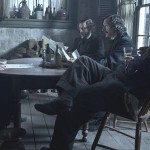 Part 10: (Hotel, Washington, DC, night) Secretary of State Seward meets with three lobbyists, Robert Latham, Richard Schell and W.N. Bilbo. They discuss a strategy for persuading –and possibly bribing—selected lame duck Democratic congressmen into supporting the Thirteenth Amendment.
Part 10: (Hotel, Washington, DC, night) Secretary of State Seward meets with three lobbyists, Robert Latham, Richard Schell and W.N. Bilbo. They discuss a strategy for persuading –and possibly bribing—selected lame duck Democratic congressmen into supporting the Thirteenth Amendment.
SCENE 5: THE HOUSE DEBATE (35:10)
[JANUARY 9, 1865]
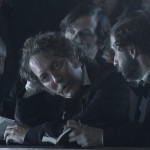 Part 11: (House of Representatives, daytime) The House Debate Begins. This scene attempts to portray the intensity of Civil War era politics and features a series of insults traded across the partisan aisle between Northern Democrats such as Fernando Wood from New York and Radical Republicans such as Thaddeus Stevens from Pennsylvania and Hiram Price from Iowa. The Seward lobbyists sit in the packed gallery (which includes Mary Lincoln and her dressmaker Elizabeth Keckley) and strategize quietly about lame duck Democrats whom they might target.
Part 11: (House of Representatives, daytime) The House Debate Begins. This scene attempts to portray the intensity of Civil War era politics and features a series of insults traded across the partisan aisle between Northern Democrats such as Fernando Wood from New York and Radical Republicans such as Thaddeus Stevens from Pennsylvania and Hiram Price from Iowa. The Seward lobbyists sit in the packed gallery (which includes Mary Lincoln and her dressmaker Elizabeth Keckley) and strategize quietly about lame duck Democrats whom they might target.
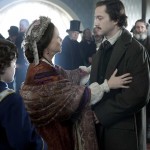 Part 12: (White House, daytime) Robert Lincoln returns from Harvard to a crowded White House corridor filled with petitioners and his younger brother Tad being pulled wildly along in a cart by a goat. Robert talks with his mother.
Part 12: (White House, daytime) Robert Lincoln returns from Harvard to a crowded White House corridor filled with petitioners and his younger brother Tad being pulled wildly along in a cart by a goat. Robert talks with his mother.
SCENE 6: GETTING OUT THE VOTE (40:30)
Part 13: (Various locations around Washington, day and night) Robert Lincoln tries to see his father, but President Lincoln focuses instead on finishing a discussion with Preston Blair, who has returned from Richmond with news about peace talks. A series of short snapshots show the Seward Lobby (Latham, Schell and Bilbo) in action, targeting a series of lame duck Democratic congressmen with offers of administration jobs and cash in exchange for switching votes in favor of the Thirteenth Amendment.
SCENE 7: SEEDS OF TIME (45:55)
[JANUARY 11, 1865]
Part 14: (White House office, early evening) The President and Secretary Seward discuss the state of the lobbying efforts and Seward reveals his anger at the President’s decision to authorize peace negotiations without consulting him. The scene then shifts briefly to “No Man’s Land” outside of Petersburg, VA and captures the Confederate officials being transported into Union lines, before returning the point-of-view to the White House for the heated argument between Seward and Lincoln over Blair’s intervention in the peace process.
[JANUARY 12, 1865]
Quick cut-away shows Confederate officials arriving at City Point –Grant’s Headquarters
[JANUARY 14, 1865]
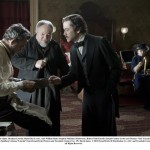 Part 15: (White House bedrooms, late afternoon) Tad and Robert are in Lincoln’s bedroom while the president dresses for the Grand Reception. Robert is pushing his father to allow him to serve in the military. Tad has a revealing discussion with free black servants William Slade and Elizabeth Keckley about slavery. The president then walks down the hall and discovers Mary Lincoln sitting alone in their dead son Willie’s former bedroom. They discuss her grief, recalling how he had died during a previous White House reception in 1862.
Part 15: (White House bedrooms, late afternoon) Tad and Robert are in Lincoln’s bedroom while the president dresses for the Grand Reception. Robert is pushing his father to allow him to serve in the military. Tad has a revealing discussion with free black servants William Slade and Elizabeth Keckley about slavery. The president then walks down the hall and discovers Mary Lincoln sitting alone in their dead son Willie’s former bedroom. They discuss her grief, recalling how he had died during a previous White House reception in 1862.
SCENE 8: GRAND RECEPTION (52:55)
Part 16: (White House reception room, early evening) Mary Lincoln cautiously greets leading Radicals in the receiving line for the Grand Reception and engages in a particularly tension-filled conversation with Thaddeus Stevens.
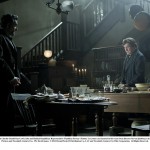 Part 17: (White House kitchen, evening) President Lincoln and Congressman Stevens have a private discussion about the proposed anti-slavery amendment and a revealing argument about differences in strategy and tactics.
Part 17: (White House kitchen, evening) President Lincoln and Congressman Stevens have a private discussion about the proposed anti-slavery amendment and a revealing argument about differences in strategy and tactics.
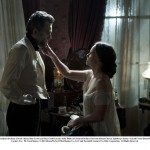 Part 18: (Mary Lincoln’s boudoir, White House, late evening) Lincoln helps his wife undress after the reception but they are interrupted by news brought by aide John Nicolay that the assault has begun on Fort Fisher outside of Wilmington.
Part 18: (Mary Lincoln’s boudoir, White House, late evening) Lincoln helps his wife undress after the reception but they are interrupted by news brought by aide John Nicolay that the assault has begun on Fort Fisher outside of Wilmington.
SCENE 9: FALLEN AT WILMINGTON (59:45)
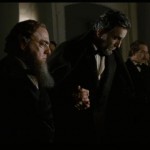 Part 19: (War Department telegraph office, late night) There is commotion and anxiety apparent in the telegraph office as Secretary of War Edwin Stanton, Secretary of Navy Gideon Welles and telegraph officer Thomas Eckert discuss the assault on Fort Fisher. Suddenly, a seated President Lincoln interrupts the exchange with a funny story about Ethan Allen that appears to relieve some of the tension until news finally arrives that Union forces have prevailed at the Fort, though not yet at the city of Wilmington, and at the cost of yet another round of bloody casualties.
Part 19: (War Department telegraph office, late night) There is commotion and anxiety apparent in the telegraph office as Secretary of War Edwin Stanton, Secretary of Navy Gideon Welles and telegraph officer Thomas Eckert discuss the assault on Fort Fisher. Suddenly, a seated President Lincoln interrupts the exchange with a funny story about Ethan Allen that appears to relieve some of the tension until news finally arrives that Union forces have prevailed at the Fort, though not yet at the city of Wilmington, and at the cost of yet another round of bloody casualties.
[JANUARY 16, 17, 18, OR 19, 1865]
 Part 20: (House chamber, daytime) Democratic congressman Fernando Wood discusses the aftermath of the bloody assault on Fort Fisher with one of his colleagues while Radical Republican leaders gather among themselves. Democratic congressman George Yeaman (KY) announces that he plans to oppose the anti-slavery amendment while some of the Seward lobbyists plot ways to switch his vote from their perch in the gallery.
Part 20: (House chamber, daytime) Democratic congressman Fernando Wood discusses the aftermath of the bloody assault on Fort Fisher with one of his colleagues while Radical Republican leaders gather among themselves. Democratic congressman George Yeaman (KY) announces that he plans to oppose the anti-slavery amendment while some of the Seward lobbyists plot ways to switch his vote from their perch in the gallery.
 Part 21: (House committee room, daytime) Fernando Wood reveals to Congressman Clay Hawkins that he has become aware of Hawkins’ plans to sell his vote on the amendment.
Part 21: (House committee room, daytime) Fernando Wood reveals to Congressman Clay Hawkins that he has become aware of Hawkins’ plans to sell his vote on the amendment.
Part 22: (Outside in woods, morning) Clay Hawkins and W.N. Bilbo, the lobbyist, are hunting and discussing their deal. Hawkins seems spooked by the threats against him and literally starts to run away from the deal and Bilbo as they argue over his commitment.
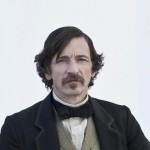 Part 23: (Washington DC alley, afternoon) The lobbyists confront Secretary of State Seward in his carriage explaining their lack of progress. There is a quick cut-away showing how one congressman tried to shoot W.N. Bilbo outside a tavern. The lobbyists then try to convince Seward that the president needs to deny the rumors about secret peace talks.
Part 23: (Washington DC alley, afternoon) The lobbyists confront Secretary of State Seward in his carriage explaining their lack of progress. There is a quick cut-away showing how one congressman tried to shoot W.N. Bilbo outside a tavern. The lobbyists then try to convince Seward that the president needs to deny the rumors about secret peace talks.
SCENE 10: NO SIXTEEN-YEAR-OLDS LEFT (1:08)
[JANUARY 20, 1865]
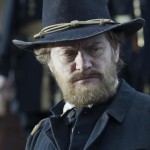 Part 24: (Outside City Point, on board River Queen steamship, daytime) General U.S. Grant negotiates with the Confederate officials, arguing with Vice President Alexander Stephens over references to “two countries” in the official dispatch the Confederates have prepared. Grant sends Lincoln a telegram urging him to meet with the Confederate envoys himself.
Part 24: (Outside City Point, on board River Queen steamship, daytime) General U.S. Grant negotiates with the Confederate officials, arguing with Vice President Alexander Stephens over references to “two countries” in the official dispatch the Confederates have prepared. Grant sends Lincoln a telegram urging him to meet with the Confederate envoys himself.
Part 25: (Seward residence, Lafayette Square, late night) Seward finishes reading the telegram from Grant with Lincoln present, wrapped in a shawl. They discuss how to proceed.
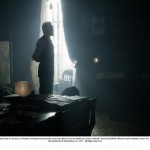 Part 26: (White House hallway, late night) President Lincoln paces in the hallway, sits lost in thought in his office, and then turns up in Nicolay’s and Hay’s bedroom in the White House, waking up his aides to discuss a pardon case. Realizing his boss’s agony, Hay offers company, but Lincoln claims he is best left alone.
Part 26: (White House hallway, late night) President Lincoln paces in the hallway, sits lost in thought in his office, and then turns up in Nicolay’s and Hay’s bedroom in the White House, waking up his aides to discuss a pardon case. Realizing his boss’s agony, Hay offers company, but Lincoln claims he is best left alone.
[JANUARY 21, 1865]
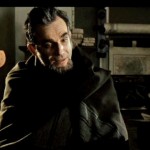 Part 27: (War Department telegraph office, pre-dawn) Lincoln now has wandered over to the telegraph office, still covered in his shawl, where he is finishing a draft reply to General Grant. Two young telegraph operators (David Homer Bates and Sam Beckwith) are with him and discuss various topics, including being “fitted” for the times and the nature of Euclid’s proofs about equality, before Lincoln finally decides to instruct Grant to bring the Confederate envoys to Hampton Roads, VA.
Part 27: (War Department telegraph office, pre-dawn) Lincoln now has wandered over to the telegraph office, still covered in his shawl, where he is finishing a draft reply to General Grant. Two young telegraph operators (David Homer Bates and Sam Beckwith) are with him and discuss various topics, including being “fitted” for the times and the nature of Euclid’s proofs about equality, before Lincoln finally decides to instruct Grant to bring the Confederate envoys to Hampton Roads, VA.
SCENE 11: EQUALITY UNDER THE LAW (1:18)
[JANUARY 27, 1865]
Part 28: (House of Representatives, morning) Anxiety rises as Thaddeus Stevens prepares to take the floor. Democratic congressmen led by Fernando Wood attempt to bait the old Radical leader into making intemperate remarks about social revolution and equality. Stevens stubbornly refuses to say anything beyond the amendment’s goal of preserving “equality before the law.” Mary Lincoln watches in admiration but her black dressmaker, Elizabeth Keckley, despises the nature of the debate and leaves the gallery abruptly. Stevens controls his tongue but hurls insults at his Democratic opponents. His junior colleague, Asa Vintner Litton, later expresses disappointment in the performance and Stevens attempts to explain and defend his refusal to promise support for civil rights at that moment.
SCENE 12: ROBERT’S AMBITION (1:24)
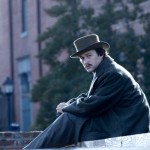 Part 29: (Washington, temporary army hospital, daytime) The president and his son Robert are visiting wounded soldiers and discussing Robert’s thwarted desire to join the army. Robert suspects the trip to see the wounded was designed to discourage him from serving. They argue and President Lincoln slaps his son outside the hospital. Robert leaves in anger.
Part 29: (Washington, temporary army hospital, daytime) The president and his son Robert are visiting wounded soldiers and discussing Robert’s thwarted desire to join the army. Robert suspects the trip to see the wounded was designed to discourage him from serving. They argue and President Lincoln slaps his son outside the hospital. Robert leaves in anger.
 Part 30: (Mary Lincoln’s boudoir, White House, nighttime) The president has decided to let his eldest son join the army and now tries to explain the decision to his wife, who fiercely objects. They argue and he leaves without winning her over.
Part 30: (Mary Lincoln’s boudoir, White House, nighttime) The president has decided to let his eldest son join the army and now tries to explain the decision to his wife, who fiercely objects. They argue and he leaves without winning her over.
Part 31: (Washington theater, evening) The Lincoln’s are attending the opera to view a performance of “Faust.” Elizabeth Keckley is also present. Mary Lincoln reveals to her husband that the only way she can reconcile his various decisions will be if he succeeds in securing the Thirteenth Amendment. That will end the war, in her opinion, and prevent her son from risking his life.
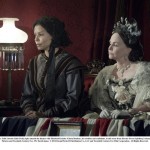 Part 32: (outside White House, nighttime) Elizabeth Keckley confronts President Lincoln alone after the night at the opera, thanking him for his “concern” about abolishing slavery but urging him to do even more. They discuss what might happen after the proposed amendment passes. Keckley claims that blacks are not worried about racial prejudices and their social and economic prospects –yet. “Freedom’s first,” she says firmly.
Part 32: (outside White House, nighttime) Elizabeth Keckley confronts President Lincoln alone after the night at the opera, thanking him for his “concern” about abolishing slavery but urging him to do even more. They discuss what might happen after the proposed amendment passes. Keckley claims that blacks are not worried about racial prejudices and their social and economic prospects –yet. “Freedom’s first,” she says firmly.
SCENE 13: BIPARTISAN SUPPORT (1:35)
[JANUARY 28, 29 OR 30, 1865]
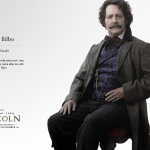 Part 33: (Hotel, Washington, late night) The disheveled, exhausted lobbyists are gathered in their hotel room. Seward enters with Lincoln in tow. The men are stunned. Bilbo even curses. Lincoln discusses strategy with them and begins firing off a series of critical directives, especially regarding a Pennsylvania Democrat named Alexander Coffroth.
Part 33: (Hotel, Washington, late night) The disheveled, exhausted lobbyists are gathered in their hotel room. Seward enters with Lincoln in tow. The men are stunned. Bilbo even curses. Lincoln discusses strategy with them and begins firing off a series of critical directives, especially regarding a Pennsylvania Democrat named Alexander Coffroth.
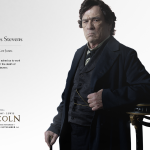 Part 34: (Thaddeus Stevens’ office, night) A nervous Alexander Coffroth enters Stevens’s office. The Radical leader informs him that if he wants to hold his seat he must switch his vote in favor of the amendment. Coffroth agrees.
Part 34: (Thaddeus Stevens’ office, night) A nervous Alexander Coffroth enters Stevens’s office. The Radical leader informs him that if he wants to hold his seat he must switch his vote in favor of the amendment. Coffroth agrees.
Part 35: (Hotel, Washington, late night) A return to the previous point-of-view as Lincoln continues his conversation with the lobbyists, now focusing on George Yeaman, a Democratic congressman from Kentucky.
SCENE 14: FAIRNESS AND FREEDOM (1:39)
Part 36: (Seward’s office, State Department, daytime) Lincoln and Seward are facing a nervous Congressman Yeaman who is resisting any switch of his vote in favor of the amendment. Lincoln attempts to persuade him, answering various objections, but the conversation ends inconclusively.
Part 37: (Home of Congressman Hutton, Washington, night) Lincoln discusses the amendment outside the front door of a Democratic congressman named Hutton, whose brother has died fighting for the Union.
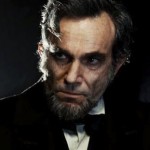 Part 38: (Lincoln’s White House office, night) The president is engaged in deep strategic discussions with Congressman Ashley, Secretary Seward, Preston and Montgomery Blair. Both aides Nicolay and Hay are present. Ashley objects to the secret peace talks. Lincoln flashes anger, demanding action “Now, now now!” When the men appear uncertain about how to obtain the remaining votes, Lincoln asserts loudly, “I am the President of the United States, clothed in immense power!”
Part 38: (Lincoln’s White House office, night) The president is engaged in deep strategic discussions with Congressman Ashley, Secretary Seward, Preston and Montgomery Blair. Both aides Nicolay and Hay are present. Ashley objects to the secret peace talks. Lincoln flashes anger, demanding action “Now, now now!” When the men appear uncertain about how to obtain the remaining votes, Lincoln asserts loudly, “I am the President of the United States, clothed in immense power!”
SCENE 15: MORNING OF THE VOTE (1:46)
[JANUARY 31, 1865]
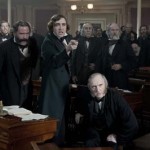 Part 39: (House of Representatives, morning) Thaddeus Stevens arrives first on the morning of the vote for the Thirteenth Amendment. The gallery fills with “well-to-do black people”, some Radical Republican senators, Lincoln’s aides, the Seward lobbyists and Mary Lincoln with Elizabeth Keckley. Congressman Vintner welcomes the black guests. The final statements begin but Democratic leader George Pendleton interrupts to announce that there are Confederate peace envoys in the city. There are calls to postpone the vote. Aaron Haddam, a conservative Republican from Kentucky, seeks guidance from Preston Blair, also seated in the gallery, who nods. Haddam then announces that conservatives cannot support the amendment “if a peace offer is being held hostage to its success.” The Seward lobbyists and Lincoln’s White House aides Nicolay and Hay rush from the Capitol to the White House.
Part 39: (House of Representatives, morning) Thaddeus Stevens arrives first on the morning of the vote for the Thirteenth Amendment. The gallery fills with “well-to-do black people”, some Radical Republican senators, Lincoln’s aides, the Seward lobbyists and Mary Lincoln with Elizabeth Keckley. Congressman Vintner welcomes the black guests. The final statements begin but Democratic leader George Pendleton interrupts to announce that there are Confederate peace envoys in the city. There are calls to postpone the vote. Aaron Haddam, a conservative Republican from Kentucky, seeks guidance from Preston Blair, also seated in the gallery, who nods. Haddam then announces that conservatives cannot support the amendment “if a peace offer is being held hostage to its success.” The Seward lobbyists and Lincoln’s White House aides Nicolay and Hay rush from the Capitol to the White House.
Part 40: (Lincoln’s White House office, afternoon) Hay makes it to Lincoln first, with Bilbo, heavily winded, behind him. Lincoln reads the motion from the House and crafts a response. Reading over his shoulder, Hay worries about the president making any false representations to Congress. Lincoln denies doing so and insists that they take his reply back to the Congress.
SCENE 16: THIS IS HISTORY (1:52)
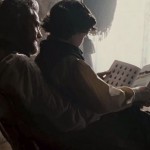 Part 41: (House of Representatives, afternoon) Congressman James Ashley reads Lincoln’s response which simply denies that any Confederate envoys are “in the city.” The Democrats denounce this as a “lawyer’s dodge” but conservative Republicans accept the answer and the voting begins. The roll call proceeds by state. Meanwhile, quick cutaways show Lincoln reading with Tad during the vote and anxious crowds following the results outside of the Capitol and at Grant’s headquarters in City Point.
Part 41: (House of Representatives, afternoon) Congressman James Ashley reads Lincoln’s response which simply denies that any Confederate envoys are “in the city.” The Democrats denounce this as a “lawyer’s dodge” but conservative Republicans accept the answer and the voting begins. The roll call proceeds by state. Meanwhile, quick cutaways show Lincoln reading with Tad during the vote and anxious crowds following the results outside of the Capitol and at Grant’s headquarters in City Point.
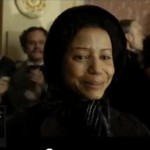 Part 42: (House of Representatives, late afternoon) The roll call proceeds until final passage is achieved. In the end, Beanpole Burton, Coffroth, Hutton, Yeaman, Hawkins, and the Speaker himself (Schuyler Colfax) who usually doesn’t participate in voting –all cast affirmative votes. The announcement sets off wild celebrations in the gallery, though the seats of the Seward lobbyists are now noticeably empty. Thaddeus Stevens takes the final bill from the stunned clerk, promising to return it the next morning.
Part 42: (House of Representatives, late afternoon) The roll call proceeds until final passage is achieved. In the end, Beanpole Burton, Coffroth, Hutton, Yeaman, Hawkins, and the Speaker himself (Schuyler Colfax) who usually doesn’t participate in voting –all cast affirmative votes. The announcement sets off wild celebrations in the gallery, though the seats of the Seward lobbyists are now noticeably empty. Thaddeus Stevens takes the final bill from the stunned clerk, promising to return it the next morning.
SCENE 17: CELEBRATION (2:02)
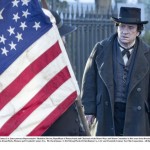 Part 43: (Stevens residence, evening) Thaddeus Stevens limps home on his club foot carrying the final bill and presents it to Lydia Smith, his black housekeeper. They are lovers as well, however, and the scene switches to their bedroom where they lay together joyfully reading the words of the Amendment.
Part 43: (Stevens residence, evening) Thaddeus Stevens limps home on his club foot carrying the final bill and presents it to Lydia Smith, his black housekeeper. They are lovers as well, however, and the scene switches to their bedroom where they lay together joyfully reading the words of the Amendment.
[FEBRUARY 3, 1865]
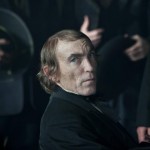 Part 44: (Fortress Monroe, Hampton Roads, VA, late afternoon) President Lincoln arrives to meet with the Confederate envoys and Secretary Seward on board the River Queen. The discussion veers back-and-forth but without resolution. Lincoln won’t yield to any of the Confederate demands.
Part 44: (Fortress Monroe, Hampton Roads, VA, late afternoon) President Lincoln arrives to meet with the Confederate envoys and Secretary Seward on board the River Queen. The discussion veers back-and-forth but without resolution. Lincoln won’t yield to any of the Confederate demands.
SCENE 18: PETERSBURG (2:09)
[APRIL 3, 1865]
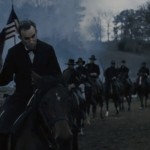 Part 45: (Outside Petersburg, VA, daytime) Lincoln moves along on horseback past dead bodies that litter a recent battlefield. Then we see Lincoln seated with Grant at the general’s temporary headquarters in what is now Union-occupied Petersburg. They discuss surrender terms for the Confederates. Lincoln observes that he had never seen carnage like he had seen that day.
Part 45: (Outside Petersburg, VA, daytime) Lincoln moves along on horseback past dead bodies that litter a recent battlefield. Then we see Lincoln seated with Grant at the general’s temporary headquarters in what is now Union-occupied Petersburg. They discuss surrender terms for the Confederates. Lincoln observes that he had never seen carnage like he had seen that day.
[APRIL 9, 1865]
Quick cut-away showing General Lee surrendering to General Grant at Appomattox. Robert Lincoln is present as a junior officer on Grant’s staff.
[APRIL 14, 1865]
Part 46: (Washington streets, carriage ride, afternoon) The President and Mrs. Lincoln are having a happy conversation about their future travel plans now that the war has essentially ended.
SCENE 19: NOW HE BELONGS TO THE AGES (2:09)
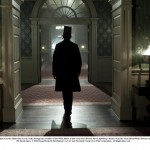 Part 47: (White House, evening) The president is getting ready to go to the theatre with help from his servant, William Slade. Congressman James Ashley and Speaker of the House Schuyler Colfax are with the president talking about his recent comments on the possibility of allowing blacks to vote. They report that Thaddeus Stevens is “furious” that Lincoln qualified the extension of suffrage within certain limits but the tone of the conversation is friendly. Nicolay interrupts to report that Mrs. Lincoln is waiting in the carriage. The men watch as Lincoln slowly walks down the hall and leaves the White House.
Part 47: (White House, evening) The president is getting ready to go to the theatre with help from his servant, William Slade. Congressman James Ashley and Speaker of the House Schuyler Colfax are with the president talking about his recent comments on the possibility of allowing blacks to vote. They report that Thaddeus Stevens is “furious” that Lincoln qualified the extension of suffrage within certain limits but the tone of the conversation is friendly. Nicolay interrupts to report that Mrs. Lincoln is waiting in the carriage. The men watch as Lincoln slowly walks down the hall and leaves the White House.
Part 48: (Grover’s Theatre, evening) A performance on the stage is interrupted by the announcement that the president has been shot at another theater. Tad Lincoln, in the audience, is rushed out in anguish as pandemonium erupts.
[APRIL 15, 1865]
Part 49: (Peterson’s Boarding House, early morning) The dying president lays on the bed in the residence across from where he had been shot at Ford’s Theatre. Cabinet officials, officers and the president’s family gather around him as he dies at 7:22 am.
[MARCH 4, 1865]
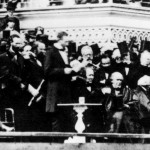 Part 50: (East Portico of the Capitol, daytime) The movie ends with a flashback to President Lincoln delivering his Second Inaugural Address.
Part 50: (East Portico of the Capitol, daytime) The movie ends with a flashback to President Lincoln delivering his Second Inaugural Address.
SCENE 20: CREDITS (2:21)
Images from the “Lincoln” movie courtesy of Dreamworks

